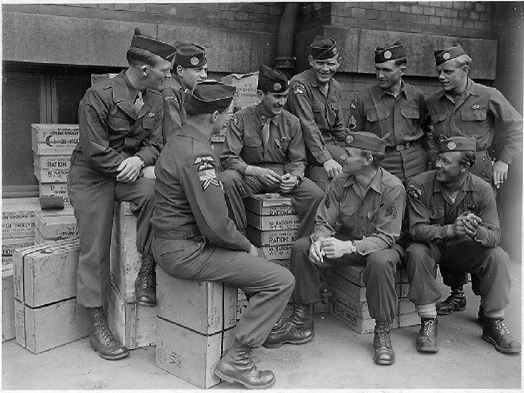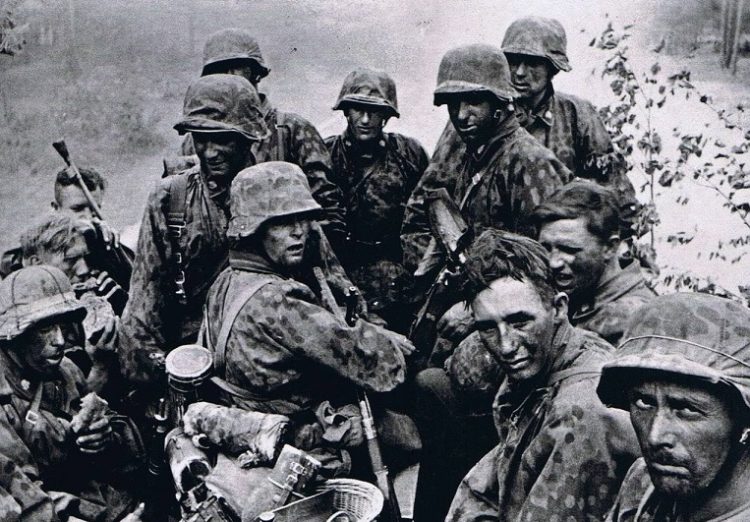The years between 1918 and 1939 were marked by intense turmoil for much of the world, as Europe, ravaged by World War I, struggled to rebuild and recover, while the U.S. brought home her late-to-the-war troops and once again downsized its military. In the Pacific, the Japanese military, who had played a limited role in the war on the side of the Entente, took advantage of Germany’s defeat to advance its interests in the region by acquiring the German military colony at Tsingtao, China. All of these events would form the perfect storm that would become the Second World War. The interwar years would find many of the world’s intelligence services lacking and playing catch up.
Germany
For Germany, the years between the world wars were as much a time of refitting and rearmament as they were of recovery. German territory had largely been untouched by the war, but being on the losing side came with consequences. An effective British blockade had brought about famine and hunger, and the largely unpopular war led to the Kaiser and the royal families abdicating, to be replaced by the Weimar Republic. Economically, Germany was suffering from hyperinflation at a time when the rest of the world was reeling from the effects of the Great Depression.
Abwehr, Germany’s military intelligence unit, was formally born in 1920. This was despite the provisions of the Treaty of Versailles, which clearly prohibited the formation of any German intelligence agency. Ignoring this, the German defense ministry established what they labeled as a “defense against foreign espionage.” (Over time, this would morph into something else completely.) The fledgling Abwehr was tasked with domestic and foreign intelligence gathering — the majority of it via HUMINT (human intelligence) — along with counterespionage.
Then in 1929, each individual military branch’s intelligence units were combined and placed under the umbrella of the Ministry of Defense under General Kurt Schleicher. Much like today, the Abwehr operated out of domestic and foreign stations. The foreign stations were first set up in neutral countries and then in occupied nations as the Blitzkrieg rolled on. In 1938, Hitler replaced the Abwehr with the OKW (or Oberkommando der Wehrmacht, “Supreme Command of the Armed Forces”) and made it a part of his personal sphere of influence.

According to an article in the online publication The Armchair General, Germany’s greatest intelligence successes came via communications intercepts and deception. Allegedly, the famous German lieutenant general (later Field Marshal) Erwin Rommel gained his best intelligence from the American military attaché in Cairo. Rommel was able to read his dispatches and gain information on the disposition of British forces in North Africa.
German HUMINT officers operated throughout Europe, Russia (early on in the war and before), and even in Asia and the United States. They gathered intelligence and recruited spies to report on everything from enemy troop movements to their own neighbors.
Japan
Most historians view Japanese intelligence during the war as largely a failure. But not everyone agrees. In a 2009 book titled “Japanese Intelligence in World War 2,” Japanese scholar Ken Kotani cautioned that the naysayers are basing their opinion mostly on the latter years of the war when the Japanese Army and Navy were fighting enemies on multiple fronts. Kotani examined the pre-war and early war years. He argues that if it were not for the intelligence gathered by Japanese spies and communications intercept forces, numerous victories over Russia, China, and Great Britain would likely not have been possible.
HUMINT and SIGINT were the hallmark methods of Japanese spying against foreign targets, while the Kampeitai (IJA police) and the War Ministry’s Investigative Department handled counterintelligence operations. The Japanese also made extensive use of OSINT (open-source intelligence) collection and support from organizations such as the South Manchurian Railway Company and the Domei News Agency.
One of Japan’s most prolific spies, Velvalee Dickinson, was actually an American. Dickinson was a shop owner in New York City who specialized in dolls. Using this as a cover, Dickinson was able to travel to the West Coast, “bump” unsuspecting targets, who had access to U.S. Navy shipyards and ask them seemingly innocent questions to gather information on ship dispositions. She would then draft a letter, again using real but unsuspecting citizens’ addresses as the point of origin, hiding the details of the intelligence within. This method of concealing a file, message, image, or video within another file, message, image, or video is known as a stenographic message.
In February 1942, in the incident that would lead to her arrest two years later, a letter was brought to the attention of the FBI. The letter, intercepted by wartime censors, was supposedly from a woman in Portland, Oregon to a correspondent in Buenos Aires, South America. It discussed a “wonderful doll hospital.” The letter also noted that the writer had sent the correspondent “three Old English dolls” for repairs, and mentioned “fishnets” and “balloons.” After pouring over the details, FBI cryptographers concluded that it was likely that the “dolls” described three warships and that the “doll hospital” was a West Coast-based shipyard where repairs were made, while the “fishing nets” and “balloons” likely described coastal defenses.
The subsequent investigation revealed an intricate network of falsified letters and money that originated from Japanese naval intelligence officers in Washington DC and New York. Dickinson was charged with espionage against the United States and was sentenced to 10 years in prison (she only served seven before being released.) In a final act of treachery, she maintained that her husband, who was of decreased mental capacity, was in fact the spy for Japan. (Indeed for better or for worse!)
United States
Probably the most “famous” spies of WWII were American, British, and French (note, I did not say the best.) The FBI maintained a highly capable domestic intelligence program and was largely responsible for spoiling German plans to incite German-Americans, which they were somewhat successful at (though it did not amount to much strategically). Yet, abroad they were a bit out of their element. More suited to the task was the Office of Strategic Service (OSS). OSS was founded in June 1942 as means of both providing a central holding for intelligence and as a way to placate the Joint Chiefs of Staff, who did not trust President Franklin D. Roosevelt’s Coordinator of Information, William Donovan. Ironically, Donovan became the first director of OSS, thus furthering the rift.

The exploits of the OSS were the stuff of legend. OSS was the precursor of the Central Intelligence Agency as well as a model for today’s U.S. Army Special Forces and unconventional warfare. Many famous names passed through its ranks, including chef Julia Childs, Pulitzer Prize winner Arthur Schlesinger, and Morris “Moe” Berg, an American catcher and coach in Major League Baseball.
A graduate of Princeton University and Columbia Law School, Berg spoke several languages and allegedly read 10 newspapers a day. As a spy, he traveled to Yugoslavia to gather intelligence on resistance groups the U.S. government was considering supporting. He was later sent on missions to Italy, where he met with and interviewed various physicists concerning the Nazi atomic program. After the war, Berg was occasionally employed by the CIA, but, by the mid-1950s, was unemployed. He spent the last two decades of his life without work, living with various siblings.
Great Britain
Following the fall of France, Prime Minister Winston Churchill tasked Minister of Economic Warfare, Hugh Dalton, with forming SOE with the instruction to ‘set Europe ablaze,’ by helping local resistance movements and conducting espionage and sabotage in enemy-held territories. Research and development stations were set up near Welwyn in Hertfordshire. Colonel Colin Gubbins was named as SOE’s first head of training and operations.
SOE recruits received extensive training in unarmed combat, firearms, sabotage, and wireless communication techniques. SOE graduates operated in countries under Nazi occupation, including France, Belgium, Greece, Albania, Yugoslavia, and Italy. They also operated, as Force 136, in the Far East against the Japanese. Agents were generally dropped by parachute, although some were transported by submarine. There was also had a Naval Section, which used small boats to put agents ashore.
At its peak, SOE boasted over 13,000 men and women within the ranks.
SOE operators volunteered, knowing fully well the risks and costs. Of the 470 members of Section F operating in France, 118 were never seen again, usually as a result of Axis counterintelligence networks. But SOE had its share of important victories, one of the most famous being the destruction of the Norsk Hydro Plant in Norway in 1943, which was manufacturing heavy water for the Nazis’ atomic bomb program.
Soviet Union
Facing a German onslaught from the west and a possible invasion from Japan in the east, Soviet leaders desperately needed intelligence on enemy troop dispositions and the intent of Axis leaders. Soviet intelligence, in the form of the NKVD (domestic security and the KGB’s forerunner) and GRU (military intelligence), had agents around the world, including in the United States.
Nevertheless, General Secretary of the Communist Party Joseph Stalin seemed more interested in which of his countrymen were traitors then on German troop movements. In fact, the long and bloody fight against Hitler’s armies in the west might have been less bloody had Soviet leadership listened to one of its most prolific spies, Richard Sorge.
Sorge was a Soviet military intelligence officer, who was active before and during the war, working undercover as a German journalist in both Nazi Germany and Japan under the codename “Ramsay.” Sorge was most famous for his time in Japan in 1940 and 1941 when he provided information about Germany’s plan to attack the Soviet Union, (though not the exact date of the attack.) Stalin chose to ignore the information, and the resulting battles ended in the deaths of millions of Soviet civilians, as well as thousands of German and Russian soldiers.
But Sorge’s efforts were not without reward.
In late 1941, he informed the Soviet command of his discovery that Japan was not going to attack the Union anytime in the near future. This allowed Stalin to order the transfer of 18 divisions, 1,700 tanks, and over 1,500 aircraft from Siberia and the Far East to the Western Front against Germans during the most dangerous months of the Battle for Moscow — one of the turning points of the whole of the war.
For his work on behalf of his country, Sorge was posthumously awarded the title of Hero of the Soviet Union in 1964.
Whatever the nation, big or small, victor or conquered, the war had changed the world forever. Territory was partitioned, walls were built, and once again, ideologies were set against one another resulting in an Iron Curtain being drawn across the Soviet Union. The United States and her allies would now, more than ever, have to rely on the men and women of their intelligence agencies to find out what went on behind it.
This article was originally published in 2015.










COMMENTS
You must become a subscriber or login to view or post comments on this article.